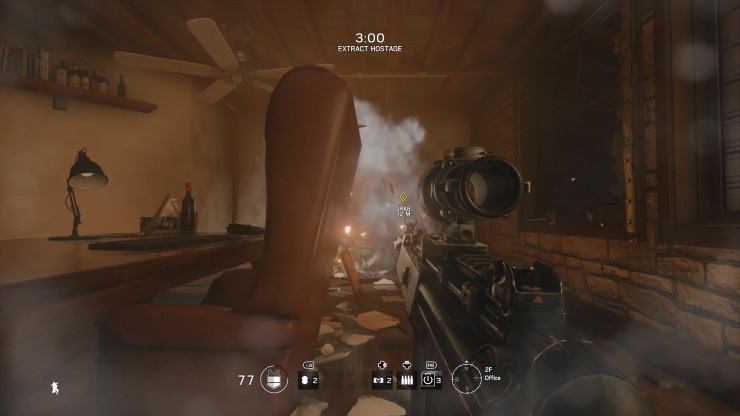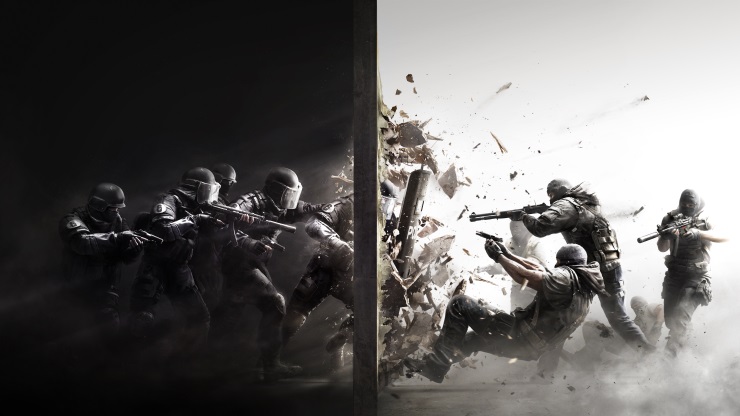December 1, 2015.
Every year, Ubisoft pull out something big during their E3 press conference that looks incredible and steals the show. Unfortunately, pretty much every time that has happened the final product that launches (usually a good few years later) fails to live up to the expectations set by that initial unveiling. Rainbow Six Siege could be the one that breaks this curse, but it isn’t without its own set of glaring issues.
That E3 reveal that we all remember showed off the multiplayer mode where one team of terrorists held a hostage in a house while a group of elite soldiers had to infiltrate it, kill off the terrorists and rescue the hostage. In many aspects the final version of Siege is exactly the same as this demo. Multiplayer accounts for the bulk of the game (though there are singleplayer and co-op options that we will get to later), and one of the three main game modes is hostage rescue (although all the modes basically amount to the same thing).
At the start of each round, defenders must set up defences such as boarding up doors, setting traps and generally making life harder for the attacking team to get to the objective. While this is going on, the attacking team deploys small RC devices equipped with cameras to scout out the map. If they manage to find the objective during this phase it will be marked on the map for the rest of the round; if not, they have to go in blind. These drones can also be used to tag enemy locations for all team members to see, albeit only briefly. This starting phase is actually one of Siege’s better ideas thanks to the mind games it evokes. Initially, defenders will set up traps in fairly obvious locations which attackers will spot with the drones and later destroy, so after a while defenders move traps to new, surprising locations in an attempt to catch them out.

After the starting phase concludes, the meat of each match begins. Attackers have a certain amount of time to find the objective (if they haven’t already), and complete it or kill all five terrorists, while the terrorists will have to either kill all five attackers or wait for time to expire (or in hostage mode, hope the attackers kill the hostage.) Most of the time, the winning team will be the one that kills the others first, with objectives rarely being the deciding factor, which when played for hours at a time starts to feel very repetitive. When you do manage to win by completing the objective it feels great; it just doesn’t happen often enough.
The issue created by most matches ending on kills and not objectives is that the defensive side has a massive advantage. Almost all the defensive specialists offer tools that help them stay alive or pick off the attackers. Being able to fortify a room strongly and camp in it may be quite boring, but it means that it’s the attackers who have to make the plays, which, unless they have a genuinely good plan or are mechanically better, will usually fail. This resulted in a lot of the games I played being a tie decided by the luck of the side draw in overtime. That’s not to say it’s impossible to win as the attackers if you have a well coordinated team, but it certainly feels like defenders have a big advantage.
That being said, almost every game is a tense and exciting experience, even when playing with friends who are more than happy to joke around. Formulating a plan as the attackers and executing it offers an adrenaline rush that few other shooters manage to replicate. The change in pace when people burst through a window or roof and all hell breaks loose is exhilarating, and at times you do become really caught up in what’s going on, actually feeling like there is a lot at stake if you mess up or miss a tiny detail that could turn a match. Playing with friends is always the best way to play and makes winning a lot easier, but that doesn’t mean fun is impossible with randoms, just don’t expect too many well coordinated attacks.
Aside from the multiplayer there is Terrorist Hunt, which takes almost the same form as the multiplayer but features AI as the opponents. You and up to four others will take on missions that are on the same maps and contain most of the same objectives as the PvP side. There is the odd change such as the addition of rounds that can only be won by killing all the terrorists in true terrorist hunt style. This is a great way to improve your skills for multiplayer and learn the systems as well as having a bit more of a relaxing time away from the high pressure environment of the full online experience. Difficulty wise, the easiest of the three options will see you die very rarely, while the realistic mode is excruciatingly hard.
Finally, there are the single player situations. Ten of these single player missions are on offer and really should be the first things you play as they act almost as an extended tutorial that will take a couple of hours to get through. Each will see you given an objective similar to those in terrorist hunt and will introduce you to a new specialist (one of the 20 playable classes). These situations are great for learning the basics, but bar the last one you probably won’t replay them. The final situation turns into a game of terrorist hunt where you team up with four others. Strangely, this is the only part of Siege that has any kind of real story and it’s quite an interesting one at that. Sticking a bit more story into the other situations would make them a lot more entertaining, but it’s not a criminal omission.
Mechanically the shooting is solid, with each weapon feeling substantially different. I never really noticed anything that was too overpowered during my time, especially on the weapons front. This meant I never really settled on one weapon that was my favourite, often jumping between multiple options. The destructible environment that was a heavy focus of that initial reveal isn’t quite at the same level as many had hoped, with quite a few surfaces remaining indestructible. However, it does often play a factor and adds an extra mechanic that you need to consider during each match. When used correctly it can be the single reason for victory, offering up extra vision lanes or using it for a surprise kill. The maps themselves are fairly varied, but many are unremarkable, with only a couple being genuinely memorable.
As previously mentioned there are 20 operators for you to chose from, although you will have to unlock them with experience points that you earn for doing literally anything positive in a game. Unlocking all 20 will take quite a while unless you buy some XP boosts (yes, you can use real money to buy these and weapon skins, and I wouldn’t say anything is reasonably priced), but usually you will find a couple of operators that suit you early on. Each of them feels unique enough and picking a good combination for each match is key.
If you and your friends are looking for a tactical multiplayer shooter then you can’t go wrong with Rainbow Six: Siege. The online action is quite simply phenomenal when played correctly, although a few balance changes to make attacking easier would improve it considerably. Things become less fun when you play alone, but it is certainly still enjoyable. Terrorist Hunt remains great entertainment and weirdly relaxing compared to the online mode, and the situations are decent enough as well. The flagship destructible environments become almost forgettable when playing, which is a testament to how well they are implemented, and the operators offer a much needed sense of variety. Few shooters feel as good as this to play, but friends are definitely needed to get the full experience.
Requires strategy.
Incredibly tense matches.
Terrorist Hunt is fantastic.
Harder to attack than defend.
Less fun with randoms.
A brilliant online experience that is tense and strategic, but one that really needs to be played with friends to get the full experience.



